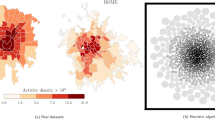Abstract
To aid in the sustainable development of cities this paper examines methods for urbanization and epidemic control. Using, as a foundation, game theory from modern control theory, a set of strategies for modeling urbanization and epidemic control are examined by analyzing and studying the current condition of China including its population, economy, resources and city management methods. Urbanization and epidemic control solving strategies are probed and the solution to a simulated example is provided. The conclusion from this research is that the speed of Chinese urbanization should be slowed to match the condition of resources and level of city management available.
Similar content being viewed by others
References
M. Jin, Citification: a strategic choice of Henan province in the new century, Circumstances and Statistics of Henan Province, pp. 4–6, Oct. 2002.
D. Zou, L. Wang, Analysis for speeding up the Liaoning province’s citifying construction, Liaoning Economic Statistics, pp. 4–7, Nov. 2002.
J. Shao, X. Liu, A game of city sickness and city development, Journal of Hunan Agricultural University, vol. 3, no. 3, pp: 69–71, 2002.
R. L. Moomaw, A. M. Shatter, Urbanization and economic development: a bias toward large city? J. Urban Economics, vol. 40, no. 1, pp: 13–37, 1996.
McDade et al., Defining the “Urban” in urbanization and health: a factor analysis approach. Social Science and Medicine, vol. 53 no. 1, pp: 55–70, 2001.
Y. Li, The change of epidemic mode, Foreign Medics: Social Medical Volume, vol. 15, no. 3, pp: 97–101, 1998.
United Nations, Migration and urbanization in Asia and Pacific: selected paper of the preconference seminar fourth Asian and Pacific population conference, Asian Population Studies Series, no. 111.
D. Wang, Employment, citification and population flowing, Zejiang Economics, no. 23, pp: 23–23, 2002.
R. Chen, Y. Zhao. A mathematic model of the control system of the population containing epidemic factors and it’s L2 state space, Journal of Northeastern Norm University, no. 1, pp: 1–7, 1989.
L. Zhao, Y. Zhao, Research for a class of time-variable epidemic control systems, Journal of Northeastern Forest University, vol. 23, no. 3, pp: 125–129, 1995.
B. Qu, A dynamic model of re-employment engineering and it’s control, System Engineering, no. 1, pp: 25–30, 1999.
F. Afshar, Balancing global city with global village, Habittal International, vol. 22, no. 4, pp: 375–387, 1988.
E. Aiyoshi, K. Shimizu, A solution method for the static constrained stackelberg problem via penalty method, IEEE. Trans. Auto. Cont., vol. AC29, no. 12, pp: 1111–1114, 1984.
T. L. Vincenty, C. S. Lee, Parametric optimization with dynamic systems, Applied Mathematics and Computation, vol. 12, no. 1, pp: 169–185, 1983.
K. Asrri, C. Le Van, Differentiability of the value function of non-classical optimal growth models, J. Optimal Theory and Applications, vol. 97, no. 3, pp: 591–604, 1998.
S. Haubruge, et al, Convergence analysis and applications of the Glowinski-Le Tallec splitting method for finding a zero of the sum of two maximal monotone operators, J. Optimal Theory and Applications, vol. 97, no. 3, pp: 645–673, 1998.
F. G. Ball, P. J. Donnelly, Strong approximations for epidemic models, Stochastic Processes and Their Applications, vol. 55, no. 1, pp: 1–21, 1995.
A. A. Batabyal, H. Beladi, On the choice of the optimal temporal control in renewable resource management, Stochastic Environmental Research and Risk Assessment, vol. 16, no. 5, pp: 325–332, 2002.
Agnieszka Wiszniewska-Matyszkiel, Discrete time dynamic games with continuum of players II: Semi-decomposable games, International Game Theory Review, vol. 5, no. 1, pp: 27–40, 2003.
A. J. van der Schaft, L2-gain analysis of nonlinear systems and nonlinear state feedback H ∞ Control, IEEE Trans. Auto. Cont., vol. 37, pp: 770–783, 1992.
Author information
Authors and Affiliations
Corresponding author
Additional information
Baida Qu received the B.S. degree in Electrical Automation from the Department of Electro-mechanical Engineering, Fuxin Mining Institute in 1982, the M.S. degree in research of MIS from the System Engineering Institute, Hefei University of Polytechnology in 1990, and the Ph.D. in research of control theory and applications from the Information Science and Engineering School, Northeastern University in 1999.
He was an electromechanical engineer at the Erdaohezi Mine at Heilongjiang Province from 1982 to 1990, a Lecturer, Senior Engineer, Associate Professor at Shenyang Institute of Technology from 1990 to 1999, and a Professor at Shenyang Institute of Technology from 1999 to 2002. He is currently a professor at the Communication and Control Engineering School, Southern Yangtze University.
His research interests are control theory and applications, including H(infinite) control, time-delay systems; system engineering, includes modeling, analysis and simulation, MIS, CMIS; power-electronics and electrical driving; signal detecting and process; industrial automation.
Rights and permissions
About this article
Cite this article
Qu, BD. Game modeling research for urbanization and epidemic control. Int J Automat Comput 2, 13–19 (2005). https://doi.org/10.1007/s11633-005-0013-5
Received:
Revised:
Issue Date:
DOI: https://doi.org/10.1007/s11633-005-0013-5




